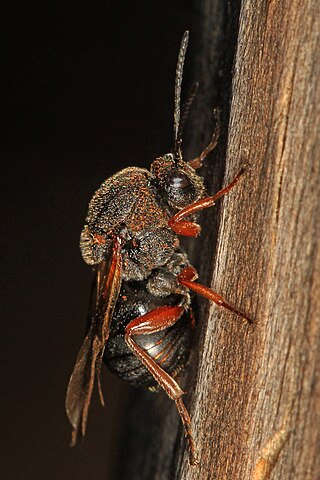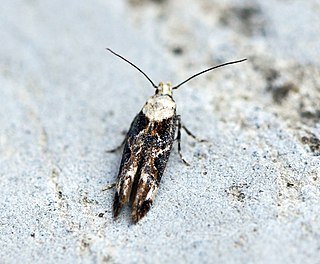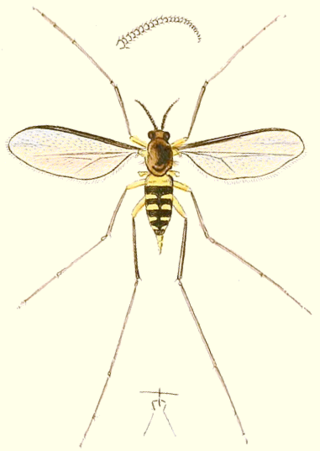
Galls or cecidia are a kind of swelling growth on the external tissues of plants, fungi, or animals. Plant galls are abnormal outgrowths of plant tissues, similar to benign tumors or warts in animals. They can be caused by various parasites, from viruses, fungi and bacteria, to other plants, insects and mites. Plant galls are often highly organized structures so that the cause of the gall can often be determined without the actual agent being identified. This applies particularly to some insect and mite plant galls. The study of plant galls is known as cecidology.

Gall wasps, also incorrectly called gallflies, are hymenopterans of the family Cynipidae in the wasp superfamily Cynipoidea. Their common name comes from the galls they induce on plants for larval development. About 1,300 species of this generally very small creature are known worldwide, with about 360 species of 36 different genera in Europe and some 800 species in North America.

Manduca quinquemaculata, the five-spotted hawkmoth, is a brown and gray hawk moth of the family Sphingidae. The caterpillar, often referred to as the tomato hornworm, can be a major pest in gardens; they get their name from a dark projection on their posterior end and their use of tomatoes as host plants. Tomato hornworms are closely related to the tobacco hornworm Manduca sexta. This confusion arises because caterpillars of both species have similar morphologies and feed on the foliage of various plants from the family Solanaceae, so either species can be found on tobacco or tomato leaves. Because of this, the plant on which the caterpillar is found does not indicate its species.
The gall adelgid is an adelgid species that produces galls in spruce trees. They infect the new buds of native spruce trees in the foothills of the Rocky Mountains in the spring. They also attack blue spruce to a lesser degree. The insects complete two generations within the year. They require two different trees for its life cycle, the second being the Rocky Mountain Douglas-fir. They may also attack Sitka, Engelmann, or white spruce. The many different species of adelgids produce different galls on different spruce species.

Blastodacna atra, the apple pith moth, is a moth of the family Elachistidae. It is known from most of Europe and it has been introduced to North America.

Synanthedon formicaeformis, the red-tipped clearwing, is a moth of the family Sesiidae and can be found in all of Europe, the eastern Palearctic realm, and the Near East. The larvae sometimes form pear-shaped galls on willows. It was first described by Eugenius Johann Christoph Esper in 1783.

Blastodacna is a genus of moths of the family Elachistidae.

Monoptilota is a genus of snout moths. It was described by George Duryea Hulst in 1900. It contains only one species, the lima-bean vine borer moth, which is found in the central and south-eastern parts of the United States.
Blastodacna rossica is a moth in the family Elachistidae. It is found on the Crimea and in the western part of Transcaucasia and central Asia.

Blastodacna hellerella is a moth in the family Elachistidae. It is found in most of Europe except the north. In the east, the range extends to the Caucasus.
Haplochrois theae is a species of moth of the family Elachistidae. It is found from western Transcaucasia and Anatolia to China. It probably originated from Southeast Asia. During the 20th century, this species was a serious pest on tea plantations in Georgia and to a lesser degree, in the Krasnodar Territory of Russia.

Mompha divisella is a moth in the family Momphidae. It is found from southern Scandinavia to the Caucasus and central Asia.

Andricus quercuscalifornicus, or the California gall wasp, is a small wasp species that induces oak apple galls on white oaks, primarily the Valley Oak but also other species such as Quercus berberidifolia. The California gall wasp is considered an ecosystem engineer, capable of manipulating the growth of galls for their own development. It is found from Washington, Oregon, and California to northern regions of Mexico. Often multiple wasps in different life stages occupy the same gall. The induced galls help establish complex insect communities, promoting the diversification in niche differentiation. Furthermore, the adaptive value of these galls could be attributed their ecological benefits such as nutrition, provision of microenvironment, and enemy avoidance.
Blastodacna pyrigalla, the pear shoot gall moth or pear fruit borer, is a moth in the family Elachistidae. It was described by Yang in 1977. It is found in Korea and China.

Andricus inflator is a species of gall-forming wasps, in the genus Andricus, which has a sexual and an asexual generation, producing two different galls. The wasp was named by the German biologist Theodor Hartig, in 1840 and is found in Europe.

Disholcaspis quercusmamma, the oak rough bulletgall wasp, is a species of gall wasp in the family Cynipidae. The quercus in its name is the genus name for oak, while "mamma" is Latin for "breast", presumably a reference to the "nipple" on the gall.

Lasioptera rubi is a species of gall midge in the family Cecidomyiidae and is found in Europe. It was first described in 1803 by the German priest, botanist and entomologist, Franz von Paula Schrank. The larvae feed within the tissue of brambles, creating abnormal plant growths known as galls.
Dasineura plicatrix is a species of gall midge, an insect in the family Cecidomyiidae, found in Europe. It was described by the German entomologist Friedrich Hermann Loew in 1850. The larvae feed within the tissue of bramble leaves, creating an abnormal growth known as a plant gall.
Placochela nigripes is a gall midge which forms galls on the flower buds of elder, honeysuckle and privet. It was described by F Löw in 1877.

Rhopalomyia capitata, the giant goldenrod bunch gall, is a species of gall midge in the family Cecidomyiidae. It is found across North America. They have been collected from Solidago canadensis, Solidago gigantea, and Solidago leavenworthiigallormers species page












